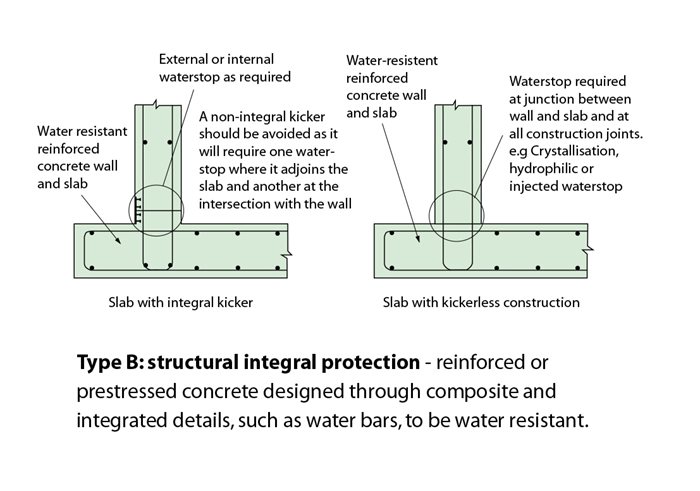Type B (Structurally Integral) System

The watertightness of the Type B construction is reliant upon the design and construction of the basement as an integral shell, using a concrete of low permeability, and appropriate joint details.
Defects can be minimised by correct specification and design and by careful construction. The most common defects are: permeable concrete and honeycombing through lack of compaction; contamination of, or cold, construction joints; cracking due to thermal contraction and shrinkage.
Construction joints need particular attention as these are the areas most commonly associated with leaks. While attention needs to be paid to jointing and positioning of water stops, great care is required in the placing and compacting the concrete. An alternative method of controlling water ingress at construction joints is to use a crystallisation or hydrophilic system that reacts in the presence of water to seal the joint. Other systems are also used.
The construction of a ‘kicker’ after pouring the floor slab should not be encouraged as it is difficult to construct without defects. Therefore kickers should be cast with the slab using appropriate edge formwork but will require careful construction to obtain full compaction.. Moderm types of formwork and kickerless construction techniques mean that kickers no longer need be part of the construction process.
With a high water table, minor defects in the concrete usually result in only small amounts of water penetrating, and stopping these is usually fairly straightforward. Remedial action may, depending on the form of construction, be carried out from the inside, so avoiding the need for external excavation.
Variable water tables present less of a problem, unless the water table stays high for a long time. In a free-draining site, it is rare for a defect to be so serious that the water comes through by capillary action. The water and water vapour resistance of Type B protection relies on the materials incorporated into the external shell of the structure itself and will be a function of the section thickness.
Further information is available from our guidance document Basements: Waterproofing